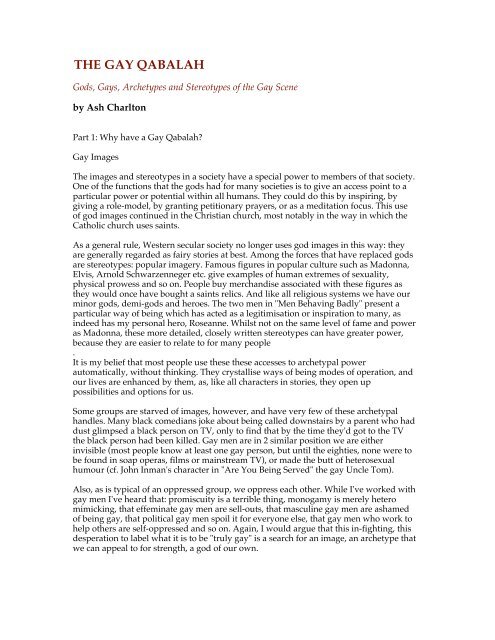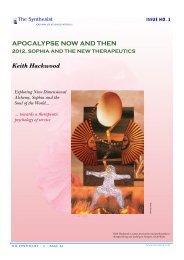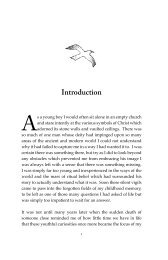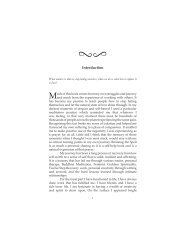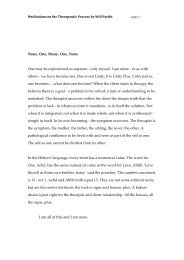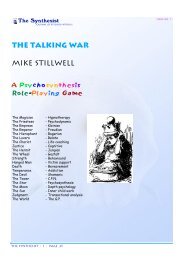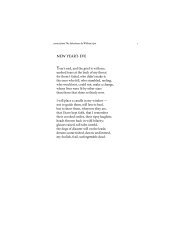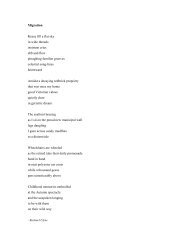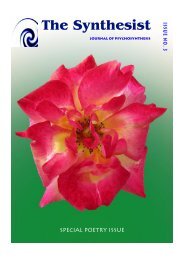THE GAY QABALAH - Will Parfitt
THE GAY QABALAH - Will Parfitt
THE GAY QABALAH - Will Parfitt
Create successful ePaper yourself
Turn your PDF publications into a flip-book with our unique Google optimized e-Paper software.
<strong>THE</strong> <strong>GAY</strong> <strong>QABALAH</strong><br />
Gods, Gays, Archetypes and Stereotypes of the Gay Scene<br />
by Ash Charlton<br />
Part 1: Why have a Gay Qabalah<br />
Gay Images<br />
The images and stereotypes in a society have a special power to members of that society.<br />
One of the functions that the gods had for many societies is to give an access point to a<br />
particular power or potential within all humans. They could do this by inspiring, by<br />
giving a role-model, by granting petitionary prayers, or as a meditation focus. This use<br />
of god images continued in the Christian church, most notably in the way in which the<br />
Catholic church uses saints.<br />
As a general rule, Western secular society no longer uses god images in this way: they<br />
are generally regarded as fairy stories at best. Among the forces that have replaced gods<br />
are stereotypes: popular imagery. Famous figures in popular culture such as Madonna,<br />
Elvis, Arnold Schwarzenneger etc. give examples of human extremes of sexuality,<br />
physical prowess and so on. People buy merchandise associated with these figures as<br />
they would once have bought a saints relics. And like all religious systems we have our<br />
minor gods, demi-gods and heroes. The two men in "Men Behaving Badly" present a<br />
particular way of being which has acted as a legitimisation or inspiration to many, as<br />
indeed has my personal hero, Roseanne. Whilst not on the same level of fame and power<br />
as Madonna, these more detailed, closely written stereotypes can have greater power,<br />
because they are easier to relate to for many people<br />
.<br />
It is my belief that most people use these these accesses to archetypal power<br />
automatically, without thinking. They crystallise ways of being modes of operation, and<br />
our lives are enhanced by them, as, like all characters in stories, they open up<br />
possibilities and options for us.<br />
Some groups are starved of images, however, and have very few of these archetypal<br />
handles. Many black comedians joke about being called downstairs by a parent who had<br />
dust glimpsed a black person on TV, only to find that by the time they'd got to the TV<br />
the black person had been killed. Gay men are in 2 similar position we are either<br />
invisible (most people know at least one gay person, but until the eighties, none were to<br />
be found in soap operas, films or mainstream TV), or made the butt of heterosexual<br />
humour (cf. John Inman's character in "Are You Being Served" the gay Uncle Tom).<br />
Also, as is typical of an oppressed group, we oppress each other. While I've worked with<br />
gay men I've heard that: promiscuity is a terrible thing, monogamy is merely hetero<br />
mimicking, that effeminate gay men are sell-outs, that masculine gay men are ashamed<br />
of being gay, that political gay men spoil it for everyone else, that gay men who work to<br />
help others are self-oppressed and so on. Again, I would argue that this in-fighting, this<br />
desperation to label what it is to be "truly gay" is a search for an image, an archetype that<br />
we can appeal to for strength, a god of our own.
But why should we have only one god, when we live in such a pagan era No-one else<br />
has to live with dust one possible Way of living, of being. Heterosexual people have a<br />
huge range of images and stereotypes to draw on, starting with their (usually)<br />
heterosexual mother and father. Which is another point: we need images more than<br />
most people, because, unlike almost every other oppressed group (with the possible<br />
exception of disabled people) we are not brought up among our own kind. Each of us is<br />
a cuckoo in the nest unable to mimic the behaviour of our heterosexual family, and<br />
having to find our own way of being from an early age.<br />
So, I would argue, there is a need for an inclusive list of useful gay archetypes, to give us<br />
models of being, handles on our archetypal powers, to give us equal rights in the life<br />
choice stakes. The Qabalah is an excellent method for generating inclusive models that<br />
are in harmony with each other, and for exploring the relations between them, which is<br />
why I have used it here.<br />
Gay Spirituality<br />
Many gay men are deeply spiritual, again in a Way which is typical for an oppressed<br />
people. In addition, many of the approved "good lives": to marry, to have children etc,<br />
are blocked to us/ and so we have to seek meaning elsewhere. A great many gay people<br />
are on a spiritual quest, but for most of them it is a road to nowhere. There is no<br />
established world religion which is truly tolerant of gay men, and a great many which<br />
are actively hostile. Our options are to sneak into a liberal wing of an established<br />
religion (as gay Christians and dews do), knowing that the majority of practitioners of<br />
that religion wish we weren't there, or to find new religions, with all the attendant<br />
problems of choice, and the risk of exploitation. Furthermore, even these new religions<br />
are usually essentially heterosexual, based on certain models of child rearing and<br />
partnership which are not relevant to many gay men. We still have to care ourselves a<br />
niche in these New Age religions as the (very few) gay and lesbian members of<br />
communities like Findhorn have found.<br />
As a result, we tend to be spiritual patch workers, swiping a bit of Buddhism, a bit of<br />
Western Mystical Tradition etc, and ending up with highly personal spiritual systems<br />
which cannot really be shared as they are so idiosyncratic.<br />
The advantage of the Qabalah is that is has a good pedigree, it's been going for ages, it's<br />
inclusive, and, more than anything else, it's adaptable. Furthermore there is a strong<br />
tradition of filling it with relevant material, and using it for specific purposes, as the<br />
Western Mystical Tradition has done, and also as other people have done with healing<br />
systems, organisational patterns, teamwork models and so on. A gay qabalah is not a<br />
bastardisation or distortion of the qabalah's purpose (as I believe gay models of other<br />
religions tend to be): it's one of its many fulfilments.<br />
So, enough talk how does it actually work The diagram sets out the gay stereotypes to<br />
be reclaimed for use by all of us. On the sections following, I consider the spheres<br />
individually, and in the section following that, the relations between them. I will<br />
conclude by exploring some of the implications and uses of the model, and how I have<br />
applied it to my own life experience.<br />
Part 2: Spheres and Veils<br />
10. MALKUTH: PERFORMERS
Subsets: Artists, Festive Faggots<br />
Often the first sign that someone is gay, frequently seen in early childhood, is the need<br />
to perform, to show off. Possibly as a reaction to having to keep so much secret, we<br />
reveal as much as possible of what we can. Gay men as a group are famously creative,<br />
however it is in the performing arts that we seem to excel. Even in our famous<br />
appreciation of the arts, it is often from the point of view of being a "closet performer":<br />
we all want to be Cho-Cho-San singing "One Fine Day" or Brunhilde singing her<br />
immolation .<br />
The number of professional gay performers is legion: dancers, actors, singers, comedians<br />
etc.: so much so that it is almost a viable career choice for a gay man.<br />
Examples: Nigel Hawthorne, Elton John, Nidinsky.<br />
Justification: Malkuth is to do with exteriors, with expression, and also with beginnings,<br />
and so performance seems most rightly to belong here, as it is often the first sign we are<br />
gay, and it is a vital part of how we express ourselves.<br />
Also, for many of us, there is a strong attraction to the Shadow of this sphere: the Festive<br />
Faggot: the gay man who performs for straight people, puts it on, becomes a gay Uncle<br />
Tom: i.e. John Inman, who unlike Larry Grayson or Julian Clare (both of whom were<br />
bitches, see Hod), never came out, always hinted, and was always a pathetic gay man<br />
that straight people could laugh at.<br />
9. YESOD: SEXUAL PREDATORS<br />
Subsets: Clones.<br />
This is obviously the sexually predatory side of all of us: best-typified by "scene queens"<br />
who live for the next casual contact. The "clone" image, with it's sexual imagery, and<br />
ease of identification taken up and used throughout raunchy gay venues everywhere,<br />
and the most famous image of the rampantly sexual gay lifestyle - belongs here also.<br />
There is a power in this casual sex that we need to harness. Gay men tend to be less<br />
sexually possessive than straights, tend more often to have open relationships and be<br />
okay about them, because sex has a different significance for us. For many of us, it's a<br />
quick way into intimacy: I've met many friends through sexual contact: it's a rapid way<br />
of getting to know someone really well. At its best it's joyful, celebratory and<br />
tremendous fun. And there is something distinctly male about it.<br />
For example, at a famous gay celebration the men and women each had exclusive use of<br />
the pool for a period of time. The women all swam naked, and felt comfortable and safe<br />
with each other. The men swam naked too, and all had sex in the showers. I know which<br />
group I'd rather be in.<br />
Examples: Gore Vidal, Julius Caesar.<br />
Justification: The most sexually potent gay image should be in Yesod, the sphere of sex,<br />
and it is also appropriate that "pure" sex, same-sex sex for it's own sake, should be at the<br />
Foundation of a Tree. based around gay sexuality.<br />
It is also here because it is our great secret. When we are campaigning for equal rights<br />
etc., we know that heterosexual people think that we want equal rights to be the nice Mr.<br />
and Mrs. Gay couple next door who are so knowledgeable about opera and make such
nice salmon mousse. We keep quiet about how many sexual partners many, if not most,<br />
gay men have, how common promiscuity is, and how much most of us enjoy it.<br />
Wherever there is a gay scene there are casual encounters, promiscuity, orgiastic sex etc.:<br />
it seems to be an essential part of gay male sexuality: the predatory, acquisitive side of<br />
all male sexuality taken to its logical conclusion. We dust don't talk about it too much: as<br />
if we are ashamed. So it belongs in Yesod, the place of secrets.<br />
8. HOD: BITCHES<br />
Subsets: Culture Queens<br />
The verbal wit and agility of gay men's repartee is legendary. In the most homophobic of<br />
eras and societies, there is usually an accepted role for gay men as satirist and wit. And<br />
we all do it: we all camp it up a bit and have some fun. Gay men are also famous for<br />
their knowledge and appreciation of the arts, and for being skilled in various crafts<br />
(cooking, hairdressing, interior design) with a strong artistic leaning. These stereotypes,<br />
for many people, are entirely what it means to be gay.<br />
Examples Julian Clarey, Larry Grayson, Boy George, Kenneth <strong>Will</strong>iams.<br />
Justification: Hod-gods (Mercury, Loki) are famously artificers, cunning men. They are<br />
also famously verbal and cruel: if there is a sphere of verbal wit it must be this one.<br />
Knowledge, particularly of the arts, and appreciation (as opposed to inspiration) are also<br />
located in this sphere.<br />
7. NETZACH: SISSY BOYS<br />
Subsets: Dizzy Queens.<br />
Scratch any gay man and you'll find a sissy boy: scratch the sissy boy and he'll burst into<br />
tears. We all were sissy boys at one time, before we learned to be butch or bitch.<br />
Stereotypes of soppy gay men abound, and, for good or ill, they're mostly true.<br />
Everyone has a say friend who is a truly loving, sensitive, non-threatening person: a<br />
sissy boy in other words.<br />
And we all have some of the sissy boy in us. Gay men are notoriously averse to team<br />
sports, despite often being strongly into physical fitness. Team sports are too rough. As<br />
children, we tend to find ways of coping with our rough straight counterparts: usually<br />
by becoming a festive faggot, or some other more camouflaged archetype: sissy boys are<br />
far too vulnerable and sensitive to survive in a tough world.<br />
And yet they have a surprising strength: they endure. Every motherly man has a sissy<br />
boy within him, that lets him be so sensitive and caring. Only a sissy boy could bear so<br />
much of another's suffering and survive: a tough boy would break under the strain.<br />
Examples: Piotyr Tchaikovsky, the young Harvey Fierstein, fotherington-tomas.<br />
Justification: Sissy boys are our open, vulnerable, empathic, sensitive side, and so seem<br />
right for Netzach. They are notoriously intuitive, and their subset, Dizzy Queens, are<br />
famous for putting feeling before sensibility.
They are also notoriously unconcerned with specifics, and put emotional values first: if<br />
anyone is picking violets while the house is on fire, it's a sissy boy, and that is Netzach<br />
all over.<br />
INTERLUDE: <strong>THE</strong> VEIL OF PAROKETH, COMING OUT<br />
Traditionally on the Tree of Life, the bottom four spheres are divided from the next three<br />
by a veil, called Paroketh, or, sometimes, truth. In the gay qabalah I would argue that<br />
this "truth" is coming out, which is such a necessary part of our experience. Where two<br />
or more gay men are gathered, there they will compare coming.out stories: it is our rite<br />
of passage.<br />
All of the stages below the veil can be done from the closet: Freddie Mercury, Nigel<br />
Hawthorne, Piotyr Tchaikovsky and Kenneth <strong>Will</strong>iams did most or all of their work<br />
without coming out: with the exception of Hawthorne, recently, none of them ever<br />
"came out" even though with most of them the truth was obvious.<br />
Performers, bitches, sissies and sexual predators don't need to be "out" as gay, and are<br />
often very resistant to the idea of it, as if the honesty of being "out" would detract from<br />
their performance, their bitchery.<br />
I do not wish to make moral judgments about being "out" or "in": we all have times<br />
when we use both: no-one is "out" on a bus full of Millwall supporters (to my eternal<br />
shame I discreetly removed my Gay Pride badge in this circumstance once), no-one is<br />
"in" while they're having casual sex (or else why bother). The point is, that to openly<br />
love another person, to be a gay politico or, to a lesser extent, to care for others, requires<br />
a more full expression of one's true nature than the previous four spheres, and so will<br />
tend to rend the veil of deception (as Paroketh must look from the other side).<br />
Not all of the people below the veil are in the closet: not all of those above are out of it.<br />
The point is, the probability of having to come out is much higher for the archetypes<br />
above the veil than below it: the forces that encourage one (like being loved by someone<br />
of the same sex) or force one (like needing to take a public stand for gay rights) are much<br />
stronger.<br />
6. TlPHARETH: HOMOEROS<br />
Subsets: Loving personal gay<br />
relationships<br />
This is really what it is all about. Anyone can have sex with someone of the same sex,<br />
and in single.sex environments (such as prison) this behaviour is very common. Not<br />
everyone who does so is gay, or would choose to have this kind of sex if their preferred<br />
kind were available. What separates us from straight people is not sex, {out love. We are<br />
homophilic: we love people of the same sex: we fall in love with them and want to be<br />
with them for the rest of our lives, in one kind of relationship or other. And I make a<br />
distinction here Between sex and love, and love and being-in-love. I have had sex with<br />
men and women, have loved men and women, but have only fallen in love with men, no<br />
matter how unsuitable they may be, and no matter how many beautiful and wonderful<br />
women I have known. I once read the term Homoeros to describe this ability to fall on<br />
love with the same sex, and, with it's demigod like overtones, feel that it fits well.
Examples: Socrates, Plato, Hadrian<br />
Justification: Gods of Tiphareth are often gods of loving: Baldur, Apollo, Christ. Love is<br />
the harmoniser, and it is the thing which makes the loved one beautiful (thinking here<br />
that Tiphareth means beauty). When we are in love we are a child (lovers talking baby<br />
talk), a king (we feel infinitely powerful) and a sacrificed god (as we give up our<br />
personal godhood, our grandiosity that we need no-one).<br />
It is also the one force which can truly unite us, and create harmony among us. God<br />
knows we can bitch about each other, disagree politically, betray each other sexually and<br />
so on, but our great redeeming factor, h, us as for all humans, is that we can love deeply<br />
and intimately.<br />
This is also important, because it is the main thing that oppressive societies try to deny<br />
us. Either by refusing to recognise our relationships, or by denying that we are capable<br />
of love (it is a keystone of psychoanalysis that gay men are undeveloped human beings<br />
and so incapable of true adult intimate love). The spirit of Homoeros gives the lie to all<br />
that. We love. We can love. We must never forget that. It gives us a huge quiet strength,<br />
that doesn't need to combat or overwhelm: once you realise that as a gay man you can<br />
love or be loved, nothing is ever the same again.<br />
5. GEBURAH: POLITICOS<br />
There were gay politicos before the AIDS epidemic, but the breed has multiplied greatly<br />
along with the virus. These days as well as the Stonewall group, we also have Outrage<br />
and ActUp. It may seem odd to lump such different groups with such different agendas<br />
altogether, but the thing that they all have in common is a rejection of the way things<br />
are, and a demand for change. They are radical groups, campaigning groups: ultimately,<br />
in the kind of stunt.tactics used by Outrage they are fighting groups of a sort. They are<br />
the people who organise marches and lobby MP's. Their work often requires bravery<br />
and always requires discipline.<br />
This is a latter day development of a very ancient role for gay men. The famed warriors<br />
of Sparta were famously homophilic, and the principle of the Theban Band (a regiment<br />
of gay lovers, who would fight all the stronger alongside their loved ones) is based on<br />
the legendary bravery of gay men .<br />
Examples Peter Tatchell, Chris Smith MP.<br />
Justification: The ability to reject, and the need for discipline are both obvious Geburah<br />
qualities. Even in the Shadow-set of Angry Politicos they are like the "regular" Geburah<br />
subset of Warriors. Politicos often find it hard to compromise (never an overwhelming<br />
Geburah quality) and have a tendency to single-mindedness (often a Geburah vice) .<br />
4. CHESED: MO<strong>THE</strong>RLY MEN<br />
Subset: Gay parents.
Gay men have been for a long time associated with the caring professions. A surprising<br />
number of male nurses, social workers and teachers are gay men, as well as probation<br />
officers and workers in supported housing. Of the men who do "women's work", there<br />
are always a disproportionate number of gays.<br />
Despite this, these men are not necessarily camp or feminine. Often their way of caring<br />
seems very male: fatherly even. This has often been the role of gay men in other<br />
societies, such as the Zuni Native Americans.<br />
Examples: Mostly unnamed and unnoticed, lan McKellen is a good example.<br />
Justification: Mercy, unconditional positive regard, empathy and forgiveness are all<br />
essential qualities of Chesed, and they are also essential qualities of Motherly Men. Men<br />
working in the caring professions have to care for everyone under their protection, and<br />
not give any preferential treatment. A teacher is there for all his pupils, a nurse for all his<br />
patients. This quality of all. acceptance seems to me to be very Chesed.<br />
INTERLUDE: <strong>THE</strong> ABYSS, BEYOND SEXUALITY<br />
Just as the Veil of Paroketh denotes a movement into a different way of being, so the<br />
Abyss denotes a similar boundary. The boundary in this case is harder to define, but still<br />
seems to hold an essential truth. The spheres of the Ethical Triangle are very bound up<br />
with being gay: to people who largely operate from these spheres, being gay is the most<br />
important thing in their life: it defines their identity.<br />
As with the Veil of Paroketh, I wish to make clear that I think that there is nothing<br />
wrong with this. Having one's sexuality as the focus of one's life is an entirely credible<br />
life.path: one does not have to "grow out of it" or "get past it". dust as I have every<br />
respect for heterosexuals who primarily define themselves as parents, husbands, wives<br />
or members of families, I also have every respect for, for example, gay politicos who live<br />
eat and sleep being gay.<br />
However the stereotypes across the abyss seem to have a different relationship with<br />
their sexuality. They are still say, but they seem to be much more than that: it is<br />
something which is a part of them rather than something they are. To take an example,<br />
George Melly got married and forswore his gay side, and yet he's still a splendid<br />
example of a Grand Old Queen: there's more to being a grand old queen than sleeping<br />
with the right people.<br />
It is possibly for this reason that the stereotypes on the far side of the abyss are<br />
frequently more acceptable to straight people, men and women alike. They have little of<br />
the need to be cruel, the need to make political points all the time, or prove their worth<br />
by looking after others, which can be so strong are feature of spheres below the abyss. In<br />
this way they seem to be beyond the duality of gay/straight they are still gay, but not in<br />
a way which is in opposition or difference to heterosexuality: they are primarily<br />
themselves, and only incidentally say. For this reason most of the persons mentioned<br />
often have a large straight following.
3. BINAH: GRAND OLD QUEENS<br />
Subsets: Drag Queens: Lily Savage.<br />
This group almost needs no introduction. There have always been Grand Old Queens:<br />
slightly (or very) effeminate dear old things with a will of iron: this is almost what a<br />
Motherly Man grows into as he gets older. Grand Old Queens are not always asexual,<br />
but they often give off an air of being past all that: that now they exist purely for style,<br />
for appearance.<br />
Examples: Harvey Fierstein, Oscar Wilde<br />
Justification: At the head of the pillar of form there had to be . a group for whom style is<br />
everything. Grand Old Queens are our grandmothers, our benevolent guiding female<br />
spirits. Surprisingly unmalicious, unexpectedly generous, more full of heart than you<br />
would expect, grand old queens are loved (and feared a little) by dust about everyone.<br />
They also fit Binah well, because there is always an air of tragedy about them, which fits<br />
well with the Vision of Universal Sorrow thing.<br />
2. CHOCKMAH: DADDIES<br />
Subsets: Leathermen, bears.<br />
This is a bit of a hard one to explain to people outside the family, as it were. A daddy is<br />
really an aging clone: there comes a point past which you simply can't carry off such a<br />
young image, so you become something of a grand old (or at least . middle-aged) man:<br />
you're allowed to have a paunch, let your clone moustache become a moustache and<br />
beard, show off your body hair and wear lots of leather.<br />
This "type" is very familiar to gay men, and very obviously the opposite of the Grand<br />
Old Queen way of aging: basically it's an aging "butch" look. Daddies are frequently<br />
involved in politics, in relationships, or in the caring professions, but what they mostly<br />
are is daddies: larger-than-life characters -kind, supportive, and have seen it all.<br />
When they are involved in doing good works, they rarely lead or take control. Most<br />
working gay projects have a team of daddies uncomplainingly driving it from within,<br />
whilst others take the credit.<br />
Examples: No famous ones, but a very definite 'type among older gay men on the scene.<br />
Edmund White is a bit of a daddy.<br />
Justification: In their quiet way of dust getting on and doing things, Daddies are a good<br />
model of the universal will at work, particularly as they are so often doing good works.<br />
Their fatherliness (hence the nickname) or even grandfatherliness: the way that .they can<br />
seem like a kind of benevolent angel, affecting everything around them, is a kind of<br />
Universal <strong>Will</strong> thing too. And of course, they're usually greying. They really are Grand<br />
Old Men, as opposed to Grand Old Queens.<br />
1 . KE<strong>THE</strong>R: STATELY HOMOS
At a certain point a Grand Old Queen or Daddy tends to become a national treasure, for<br />
reasons which eventually seem to have nothing to do with his sexuality. Watching<br />
Quentin Crisp talk so compassionately, and with such humility and wit, you almost<br />
have to remind yourself that he's gay sometimes: he's so much himself.<br />
Stately Homos seem loved by everyone, no matter what they say or do. Much of<br />
Quentin Crisp's political view is somewhat dodgy, John Gielgud has a cruel wit, but it<br />
seems to make no difference: they seem adored by gay and straight people alike, as they<br />
seem to carry something that goes beyond sexuality, and beyond the duality of agreeing<br />
with them or not. They seem to have ultimately become themselves, in a peculiarly<br />
egoless way: I've never seen a less starry actor than Gielgud (compare him with Olivier<br />
at the same age, for example), and yet he is rivetting to watch in his kindly, self-effacing<br />
way.<br />
Examples: Quentin Crisp. John Gielgud<br />
Justification: Well, it's the ultimate, and it seems to be an almost ego-less state that I<br />
associate with Kether, it's the face of the wise old man, and it's the summit we ideally<br />
end up at.<br />
It's also the beginning. When you're young, the first gay men you hear of are usually<br />
stately homos, because they're safe. Every gay man of my age read "The Naked Civil<br />
Servant" long before they read "The Beautiful Room is Empty", much less "Tales From<br />
the City". So they are also our early inspiration: the root of the power of gayness .<br />
Part 3: Cross-checking<br />
Having established the attributions to various spheres, I'd now like to see if these "fit" or<br />
not. In this section I want to consider the relationships between the spheres, and see if<br />
these stack up as they should do.<br />
Pillars<br />
In the traditional Qabalah the right-hand pillar (as you look at the diagram: the one<br />
containing Binah, Geburah and Hod) is the pillar of form: the left hand pillar, the pillar<br />
of force. There is also an association of masculinity with the two lower spheres on the<br />
right, and of femininity in the two lower on the left: this is reversed above the abyss.<br />
This distinction seems to hold strong in the gay qabalah. Bitches, politicos and grand old<br />
queens all seem to have an agenda of how the world should be: based around the<br />
individual bitch's criticisms, the politico's politics and the queen's sense of style. The<br />
right hand pillar on the other hand contains more subtle motive forces: emotions of<br />
vulnerability (which could give rise to bitchery or a wish to change things), a need to<br />
care (which could give rise to political awareness) and the pure motive force itself:<br />
daddies who keep things going.<br />
The masculine/feminine distinction is subtly altered. Certainly bitch is a more<br />
masculine' role than sissy, politico more masculine than carer, and, the switch after the<br />
abyss, daddies are more masculine than queens. There is also, as you would expect in a<br />
diagram about same-sex forces, a subtle skew to the whole male female thing. The right<br />
hand pillar really becomes the pillar of "hard femininity", the left pillar that of "soft<br />
masculinity". Most of the right hand roles seem lifted from stereotypes of strong women:
itches, the kind of larger-life-woman that drag queens like to imitate (best exemplified<br />
by Dame Edith Evans as Lady Bracknell). Even our politics is based more around<br />
feminist conscious-raising politics than masculine party politics. The left hand roles, on<br />
the other hand, are very much the soft, kind father masculine roles. A character for the<br />
whole of the right pillar would be someone like Boudicca a character for the left hand,<br />
someone like Santa Claus.<br />
Up and Down<br />
As I said earlier, the tree should contain no superior or inferior spheres, and should be<br />
equally "readable" up and down, from Kether to Malkuth and Malkuth to Kether.<br />
Going from Malkuth to Kether, we could-almost chart the life cycle of an individual gay<br />
man. Starting off as a performer (Malkuth), as we all seem to, on a variety of stages,<br />
discovering sex (Yesod) as a force (and h, many of us it is here, in our early sexual<br />
fantasies that we become aware of how different we are from our straight families), we<br />
then have the choice of how to respond to our differences: do we grow a brittle<br />
protective shell: become a bitch (Hod) Or do we wear our vulnerabilities on the outside,<br />
and proclaim ourselves as a sissy boy (Netzach) Whatever role, or mixture of roles we<br />
take, this choice always requires a deeper level of acceptance of the truth of what we are,<br />
which usually results, these days, in coming out (Veil of Paroketh). The next step on our<br />
development is usually to fall in love with a man, (Tiphareth) for most of us this<br />
happens in our teens and is sadly unrequited. This experience usually adds a new<br />
dimension to our difference: it shows us how essential to our nature it is. It also makes<br />
us more aware of the suffering of others, and presents us with a new choice: to fight the<br />
oppression that causes the suffering (Geburah) or to nurture it's victims (Chesed).<br />
Whatever path we take, we inevitably come to a point in our lives when being gay is not<br />
enough, when a purely gay identity is too small for what we are (crossing the abyss).<br />
Our politics becomes less angry, our need to care less compulsive, and we usually<br />
decide to loosen up, to keep our commitments but have a little fun with it. We either<br />
become a grand queen making grand shrieking gestures and having a wonderful time<br />
(Binah); or a laid-back daddy, doing our bit but not getting to uptight about it<br />
(Chockmah). Finally we become part of the fixed landscape of other gay men: a stately<br />
homo (Kether).<br />
From Kether to Malkuth tells a different story: it tells the story of gay liberation in our<br />
time. There have always been stately homos: people that everyone knew were gay, but<br />
provided they weren't too "out" about it, accepted by their (mostly upper-class) peers.<br />
The "homintern" of W.H. Auden, E.M. Foster and Bendamin Britten is a good example of<br />
this.<br />
Inspired by these rare visible gays, there arise two other early forces: drag queens, who<br />
have a long history of semi-acceptability, and daddies: the earliest gay activists, men like<br />
the founders of the Mattachine society. They were mostly middle-aged or older, and<br />
secure enough in their lives and jobs to risk coming out.<br />
Once these forces had been at work for lore enough, they gave rise to openly gay people<br />
being "out" in the caring professions, showing how valuable we can.be to society. Once<br />
there were enough straight people who have been cared for by a wonderful gay nurse,<br />
or who have a wonderfully supportive gay friend, then we had need of a political wing:<br />
campaigning groups who could mobilise gay and straight support. The early gay<br />
liberation front arose in this way.
And the first thing we campaigned for, after the right to exist, is usually the ,right to<br />
recognised partnership: the right to Homoeros: partly because it is at the core of what<br />
we are, and partly, it must be admitted, that it is the side of us that straight people often<br />
feel the most at home with.<br />
Once you have the luxury of a little gay reform and a commercial gay scene, people can<br />
be open sissy boys (the world was too dangerous before to be dust a sissy boy: you had<br />
to be a grand queen as well), and "out" gay satirists like Julian Clarey: bitches. I would<br />
say that this is where we are at present.<br />
I think the next step would be a recognition of gay sexuality, and it's difference from<br />
straight sexuality (so far most of the liberation movements have, for obvious reasons,<br />
stressed its similarity: "we are dust like you"). dust as feminism - the campaign for<br />
women to have the same rights as men - gave rise to post feminism - the recognition that<br />
not all the men have is worth having - so we will need at some point some kind of postintegrationist<br />
politics that takes account of the orgiastic nature of much gay sex.<br />
Something of this revolution has already taken place among professionals who work in<br />
the AIDS/ HIV field.<br />
And only then, finally, would it be safe for mainstream performers to "come out", and<br />
we'd see dust how many there are. This process has begun already, with individuals like<br />
George Michael and Nigel Hawthorne being more open about their sexuality (and of<br />
course dear old Sir John), but we are a long way from the day when Tom Cruise can be<br />
out and continue to play romantic leads, or Eddie Murphy can be out and continue to be<br />
a (more-or-less) family entertainer.<br />
Both of these cross-checks seem to bear out the internal logic of the gay qabalah. In the<br />
next section I would like to discuss its possible uses.<br />
Part 4: Practical Uses<br />
I have only been working with the gay Qabalah for a short while, but I have already<br />
found it to be a useful way of accessing these valuable gay archetypes. To give some<br />
examples:<br />
A.Inclusiveness: Like many vaguely-politico gay men I have had difficulty with the<br />
images of drag queens, particularly the way in which they are often taken by the straight<br />
press to represent the whole of gay culture (much as people dressed as Klingons are<br />
taken to represent the whole of Star Trek fandom). Whilst I will always deplore drag acts<br />
which border on the misogynistic, the majority do not: they use the "older female<br />
dragon" archetype as a source of strength and satire.<br />
I find that my work on the gay qabalah eases my relationship with drag somewhat. It is<br />
a possibility, an alternative. We don't all have to do it, but those that are doing it are<br />
providing a valuable service in keeping this archetype in our consciousness in an<br />
accessible way. The way in which the qabalah keeps a number of opposing factors in<br />
balance simultaneously is an excellent device for encouraging tolerance of this kind: that<br />
something is way, not the way, and more, that the existence of a thing can make my<br />
choice not to do that thing more meaningful.<br />
B. Not Being Stuck: For me, some archetypes are dangerously attractive, and it is easy<br />
for me to get caught up in them. There are times when I think I could spend my whole<br />
life being a bitch, for example, or that being a politico is the way the truth and the life.
The gay qabalah is useful for reminding me that none of these archetypes is enough: that<br />
I have all of these spheres within me, and that they all deserve expression. Staying a<br />
bitch leaves no room for the sensitive, vulnerable sissy boy side of myself: staying a<br />
politico means that I cannot easily express care for others. The Qabalah stops me from<br />
being stuck, diminishes the attractiveness of "one-note" thinking. As the old quote says,<br />
"neither this, nor that, am I".<br />
To take this a stage further, realising that I am more than a motherly man, a politico, a<br />
probable-daddy-in-the-making, that these are aspects of me, not all of me, is very<br />
liberating. For many gay men there is a big question of "who am I to be" as straight<br />
society does not really offer us a valid way of being (other than as a sad, lonely person,<br />
or as a child molester). For this reason archetypes are particularly (and dangerously)<br />
attractive to us, and we can easily "get stuck" in one role which doesn't truly express our<br />
nature: this is why Festive Faggots can be such a bore sometimes. We've all been stuck<br />
with some gay man determined to be Oscar Wilde, camp and clever about everything,<br />
and we all know how irritating it is when you're not in the mood for it.<br />
Allowing for a gay qabalah liberates us: camp is a thing we do, not a thing we are:<br />
likewise radical politics, mothering people, sissy behaviour or promiscuity. We can<br />
choose to do or not to do any of these things, because we aren't any of them: we are the<br />
thing that chooses to use them.<br />
C. Refine and Repair: The gay Qabalah is also useful as a checklist: which spheres do<br />
you have a good relationship with Which ones a good sometimes/sometimes not so<br />
good relationship Are any repressed or denied For myself, I would categorise them<br />
thus:<br />
Good relationship: The Inner Bitch (Hod), The Motherly Man (Chesed) The Performer<br />
(Malkuth) The Grand Old Queen (Binah).<br />
Sometimes good/sometimes not: The Politico (Geburah) Homoeros (Tiphareth) The<br />
Sexual Predator (Yesod) The Daddy (Chockmah)<br />
Not good: The Sissy boy (Netzach) The Stately Homo (Kether)<br />
Which gives me an idea about where work might be needed.<br />
Part 5: Some Conclusions<br />
How can we check if this is a valid Qabalistic analysis I would suggest the following:<br />
a. Being in keeping with the spirit of the spheres: I have amended the model a bit in<br />
writing this as I wasn't sure of the "fit" of some of the spheres (for example, under<br />
Malkuth I originally had closet cases), but I am satisfied that the finished model fits<br />
really well, and doesn't seem "forced" as some Qabalistic versions of things can do. Also,<br />
as I think of the various archetypes, it gives me a new "handle" on the power of that<br />
sphere: Hod as a bitch, Chockmah as a Daddy and so on, which I think is evidence that<br />
it is a workable model<br />
b.Maintaining the same relationships with other spheres The pillars and up-and-down<br />
analysis demonstrate this, I think. I am pleased at the way in which the opposing pairs
of spheres (Binah and Chockmah, Hod and Netsach) represent genuine choices or<br />
compromises that many gay men make.<br />
c. No sphere being superior or more advanced than any other Despite a lingering guilty<br />
feeling that its better to be a bitch than anything else, I think that this largely holds true.<br />
My only concern in this regard is the Sissy Boy sphere, which doesn't seem to have<br />
enough positive qualities: although this may be a function of my relationship with my<br />
inner Sissy Boy.<br />
d. It should be "readable" in many directions: Kether to Malkuth and back again, for<br />
example: See b. above.<br />
e. It should spontaneously cause better integration of the stereotypes under discussion:<br />
Definitely see Section Four for confirmation.<br />
I feel tremendously excited by all this: it feels like a real "in": to my own nature, to the<br />
forces in other gay men which I may be in more or less sympathy with, and to the<br />
qabalah in general. The latter I particularly found with the supernal triad, which had<br />
always seemed remote and incomprehensible to me previously. Drag Queens, Daddies<br />
and Stately Homos gives me more of a handle on what these things might be much more<br />
so (for me) than Saturn, Neptune and Pluto the traditional associations.


